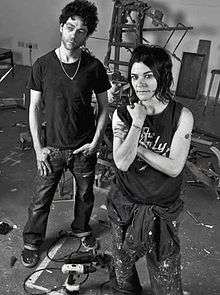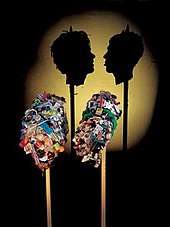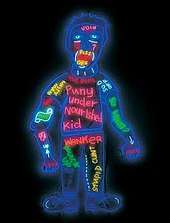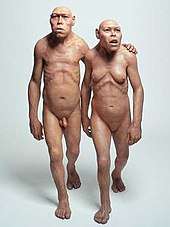Tim Noble and Sue Webster
Timothy Noble (born 1966) and Susan Webster (born 1967), are two British artists who work as a collaborative duo. They are associated with the post-YBA generation of artists.[2]
Tim Noble and Sue Webster | |
|---|---|
 Tim Noble and Sue Webster in their studio, London, UK | |
| Born | 1966 (Noble) and 1967 (Webster) |
| Nationality | English |
| Known for | Sculpture, Installation |
Notable work | Dirty White Trash (With Gulls) (1998), Kiss of Death (2003), Spinning Heads (2005), Scarlett (2006), Electric Fountain (2008)[1] |
| Movement | Post-YBAs |
| Website | timnobleandsuewebster |
Early lives and careers
Noble and Webster attended fine art foundation courses at, Cheltenham Art College (now the University of Gloucestershire) and Leicester Polytechnic (now De Montfort University) respectively. The two first met in 1986 as Fine Art students at Nottingham Trent University, became good friends through shared interests, particularly their tastes in music.[3][4]
After graduating from university in 1989, they moved to Bradford working in residency at the Nicholas Treadwell Art Mill, West Yorkshire, and in 1990–1992 worked in residency at the sculpture studios in Dean Clough.[3] Their time in Bradford had a profound effect on their artistic development, inspiring much of their early work. They later moved to London when Noble began an MA in sculpture at the Royal College of Art, which marked the pair's entrance into the London art world.[4]
Their first solo exhibition, entitled 'British Rubbish', was at the Independent Art Space (ISA) in 1996.[3][5][6] This led to them being invited to participate in numerous exhibitions, including 'Fool's Rain' at the ICA in 1996, in which they showed what they consider to be their first light sculpture; Excessive Sensual Indulgence.[4]
In 1997, while working for the artists Gilbert and George to support themselves, they developed their signature imagery, experimenting with the assemblage of personal items and household rubbish out of which came their first shadow sculpture, 'Miss Understood & Mr Meanor'[4] This work featured in their solo exhibition, 'Home Chance', mounted in their own Rivington Street studio in London.[7] The exhibition attracted large audiences, including Charles Saatchi, who bought two of the three works on show.[4]
The artist's work was included in 'Statuephilia – Contemporary Sculptors' at the British Museum, London, 2008–2009[8] and in 'Apocalypse – Beauty and Horror in Contemporary Art' at the Royal Academy London, 2000.[9] They have had solo shows at a number of other galleries in London,[10][11] and since 2000, they have enjoyed international recognition with solo exhibitions in Athens, Berlin, Boston, Moscow, New York, and Seoul.[12][13][14][15]
Their work features in a number of public collections,[3] including the National Portrait Gallery, London,[16][17] the Arken Museum of Modern Art, Denmark[18] and the Solomon R. Guggenheim Museum, New York.[19]
In 2007, they were awarded the prestigious Arken Prize,[20] and in 2009 they received Honorary Doctorates of Art from Nottingham Trent University, their former college, in acknowledgement of their artistic achievements to date.[21]
The artists are currently represented by BlainSouthern in London.
The work
Tim Noble and Sue Webster's work can be divided into the 'Light Works' and the 'Shadow Works', though Webster does not see them as completely separate. She says:
"We kept them both going side by side. There are two sides to the work; the shiny side and the dark side. That kind of reflects the two personalities within us."[22]
The influence of music on their art, particularly punk rock, has been of great importance to them since they began their earliest collaborations: Says Noble:
"I think anything that's a bit of a rocket up the arse, anything that kicks against the routine, against the mundane things that close down your mind, is a refreshing and good thing. Punk did that very successfully ... it offered a direct and instant means of producing products or things."[23]
Adds Webster:
"When we make a piece of work we're constantly looking for something that will take our breath away because if it does that to us we've pushed it as far as it will go. We like to look at every different way of making it, it can be very simple or very complicated, but we don't feel satisfied until we've both given it a good going over."[24]
Sir Norman Rosenthal, the former Exhibitions Secretary of the Royal Academy, writes:
"At the most immediate and most important level, [Tim] Noble and [Sue] Webster's work symbolizes a pair of artists clearly besotted and totally in love with each other, artists who are only interested in picturing themselves: sometimes surrounded by detritus; other times by pastiches of contemporary neon advertising. An antiaesthetic of vulgarity rules on the surface of their work."[25]
Shadow sculptures
The Shadow Sculptures incorporate diverse materials including household rubbish, scrap metal and taxidermy animals. By shining light onto these assemblages they are transformed into highly accurate shadow profiles of the artists.[26][27]

Discussing their shadow works, Webster commented: "Our work is incredibly unsocial. There has to be complete darkness because you need to give the light and then to take it away again."[28]
Their first shadow sculpture, 'Miss Understood and Mr Meanor', 1997 (right), came into existence through experimentation with the assemblage of personal items and domestic trash.[4] The silhouettes are formed by lights shining on mounds of rubbish, which includes broken sunglasses and pin badges for rock bands. In this particular work the artist's heads are severed and impaled on stakes.[4] The work was destroyed in the 2004 Momart warehouse fire, along with a number of other well-known works from the Saatchi Collection.[29][30]
Through their shadow sculptures they managed to fuse the abstract and the representational, a pursuit that consumed the likes of Jackson Pollock, Willem de Kooning and Francis Bacon.[4] This became even more apparent with their second major shadow sculpture, 'Dirty White Trash (with Gulls)', 1998 (left), which expanded the innovations of 'Miss Understood and Mr Meanor'.[31] This work is composed of a new kind of self-portrait, sculpted out of six months' worth of the artists' rubbish; the remains of everything they needed to survive during the time it took to make the work. A single light source illuminates the pile of rubbish thus casting a portrait in shadow, which contrasts sharply with the materials used to create it; the artists leaning against each other, back to back, enjoying a glass of wine and a cigarette.[31]
Jeffrey Deitch, the director of the Los Angeles Museum of Contemporary Art, writes:
"Dirty White Trash (with Gulls) is a confluence of beauty and filth, form and anti-form. It is a work of art made out of the process of its own conception, an embodiment of formalist logic. At the same time, it is a negation of everything that formalism stands for ... The artist is at the center of the work. It is deliberately entertaining, and revels in its own theatricality."[4]
Another work, 'British Wildlife' was created after Noble's father died in 2000. Using his collection of taxidermy animals, it is an assemblage of forty-six birds, forty mammals, and two stuffed fish, including a whole swan and even the pet crow Noble kept as a child.[4] The shadow formed by this mass of animals fittingly depicts back to back busts of the artists in a pose of grief.[32]
In September 2000, they were invited to participate in 'Apocalypse', the Royal Academy's follow up to the infamous Sensation exhibition of 1997. For this they presented 'The Undesirables', which comprises a mountain of detritus collected from outside Tim and Sue's house with a shadow image of the artists hovering above.[33] The appearance of a huge pile of rubbish in one of the largest galleries within the Royal Academy was intentionally radical and shocking, created to challenge viewers' assumptions about art.[34]
In 2006, an exhibition of their work was held at the Freud Museum, entitled 'Polymorphous Perverse'.[35]'Black Narcissus', a sculpture made of black silicone casts of Webster's fingers and Noble's penis in various states of arousal, was placed in Sigmund Freud's study next to a bust of Freud himself. When illuminated the sculpture cast a double profile portrait of the artists, illustrating how sexuality influences our perception of reality reflecting the sexuality that Freud discovered at the core of human life. Another work, 'Scarlett', 2006 (see below video on 'External link') was a "worktable on which numerous bizarre mechanical toys are working and seemingly in the process of being made; a nightmarish setting of repressed sexual and sadomasochistic fantasies and transgressions."[36]
Light sculptures
The light sculptures, created in tandem with their shadow investigations, are constructed out of computer sequenced light-bulbs that perpetually flash, sending out messages of, often simultaneous, love and hate. The sculptures reference the iconic pop culture symbols of Britain and America, recalling carnival shows and signage typical of working-class sea-side Britain, Piccadilly Circus, Las Vegas and Times Square.[4]

As with almost all of their work, many of the Light Sculptures are meant to be contradictory, and to produce conflicting feelings in the viewer. This is certainly the case with their early light sculpture, 'Toxic Schizophrenia', 1997. The relentlessly flashing heart with a knife stuck through it fuses a Christian emblem with a cliché rock 'n' roll tattoo. As with the shadow sculptures, duality lies at its core; the work represents romance and pain, love and hate, friendship and alienation, negative and positive.[25]
The same contradictions resonate at the centre of their later work, 'Sacrificial Heart', 2008, a three-dimensional rotating version of 'Toxic Schizophrenia', which, like the earlier work, is both repellent and strangely alluring.[37][38]'Toxic Schizophrenia (Hyper Version)' was their first permanent public sculpture, unveiled at the Museum of Contemporary Art, Denver, May 2009.[39]
Contradictions and irony abound in the works exhibited at the Gagosian, Beverley Hills exhibition, 'Instant Gratification', 2001.[23] The twenty foot long revision of their original 1997 'Forever' is inextricably linked to the artist's earlier trips to Las Vegas, playing with the traditional connotations of the word, as the constantly flashing lights reinforce the idea of 'forever'.[4]
With 'A Pair of Dollars' they attempted to form an ironic response to the art market and art fairs, creating what Noble described as a 'vulgar' artwork, to demonstrate their annoyance with this system.[22] However, he has since acknowledged the failure of this irony, due to the huge success of the piece.[22]
'Puny Undernourished Kid & Girlfriend from Hell' (Puny Undernourished Kid shown left), represents another return to earlier work, as it derives from cartoon-like drawings that Noble and Webster had made of each other ten years before.[4] These large neon figures are covered with neon tattoos of aggressive and forceful statements, clearly demonstrating the influence of punk rock on the artists.[1]
Metal sculptures
'The Crack' (2004), is one in a series of welded metal sculptures which appear at first glance as abstract works in the tradition of David Smith and Anthony Caro, while they actually work to reverse this abstraction into figuration.[4]
'The Crack', a vertical column-like form, is possibly the most difficult of the artists' shadow works to decipher. Instead of focusing on the usual black silhouettes cast on the wall, the viewer must instead focus on the white space around the shadow, which reveals the naked bodies of the artists facing each other. This perceptual challenge brings to mind Ernst Gombrich's discussion of perception in his famous 1960 book, 'Art and Illusion'.[40] 'The Crack' displays at one moment an abstract shape that is perhaps reminiscent of a heroic mountain landscape by Clyfford Still, with its cracks and gullies; gradually we begin to perceive the full-length naked profiles of our friends approaching each other, nipples touching, as though they are about to make love again for the millionth time.[25]
The New Barbarians

In 1997, Tim Noble and Sue Webster commissioned a sculptor from Madame Tussauds to help them create a life-size sculpture of themselves as australopithecines. Called 'The New Barbarians' (left), the work is based upon a diorama at the American Museum of Natural History, New York, which shows a reconstruction of two early ancestors of the human species.[41] The artists produced a version of these figures overlaid with their own facial features. The sculptures are installed so that they stand in isolation in an apparently infinite space. Their hairlessness evokes conflicting connotations; they could be the first humans or the last – cave people, or the survivors of a nuclear holocaust.[4] Thus, the work continues the artist's concern with conflicting themes of impermanence and immortality. A year after beginning 'The New Barbarians' they made another version of the work, 'Masters of the Universe', 1998–2000. This uses the same sculptural model as the earlier work but is covered with hair.
Electric Fountain
The 35-foot tall 'Electric Fountain', constructed from steel, neon tubing and 3,390 LED bulbs, was exhibited at Rockefeller Plaza, New York, February 2008.[42] 'Electric Fountain' (see 'External links' below for video clip) represents the artist's take on the world's oldest form of public art, the fountain. Said Webster: "Electric Fountain mimics the tradition of a fountain as a monument found in public squares around the world, but its magic lies in the emulation of light where water should be." The fountain can be seen as both a celebration of contemporary culture and an ambiguous comment on the nature of consumer society, embodying themes that are often present in the duo's work.[1]
The Dirty House
In 2001, Tim Noble and Sue Webster bought a dilapidated early twentieth-century furniture factory in the East End of London, which would become their studio space. The artists commissioned David Adjaye to design the building, which he named 'The Dirty House', a reference to the medium they use in many of their works.[43] The original brickwork was painted a dark brown, offset by two rows of window openings, and a 'floating' roof that appears to hover over the upper level of glazing and recessed decks.[44]
Personal lives
Noble and Webster were married on 7 June 2008. The wedding party was held on board the Queen Elizabeth, the boat that was used for the Sex Pistols' infamous 'Jubilee party'; also held on the same day as the Pistols' party, 31 years later.[45] The service was conducted by their friend and fellow artist Tracey Emin
It was announced on 4 January 2013, that after 20 years together, Noble and Webster were to divorce.[46]
See also
- Tim Mackie -Sermon on the Mount (at 14min:45 sec)
Selected articles
Selected bibliography
- Tim Noble; Sue Webster; Larry Johnson (1 August 2002). Tim Noble & Sue Webster: Instant Gratification. ISBN 978-1-880154-64-9.
- Tim Noble; Sue Webster; Mark Fletcher (2005). The Joy of Sex. ISBN 978-89-955477-4-8.
- Tim Noble; Sue Webster (5 December 2006). Wasted Youth. Rizzoli. ISBN 978-0-8478-2816-6.
- Tim Noble; Sue Webster (1 April 2008). Polymorphous Perverse. Harry N. Abrams. ISBN 978-1-904212-24-9.
- ''British Rubbish will be published by Rizzoli in Autumn 2011
See also
References
- Holzwarth, Hans W. (2009). 100 Contemporary Artists A-Z (Taschen's 25th anniversary special ed.). Köln: Taschen. pp. 428–433. ISBN 978-3-8365-1490-3.
- Trashed: A Post-YBA Couple's Collaborative Shadow Play. Village Voice, 18 November 2003
- Tim Noble; Sue Webster (5 December 2006). Wasted Youth. Rizzoli. ISBN 978-0-8478-2816-6.
- Deitch, Jeffrey, "Black Magic" in Wasted Youth New York: Rizzoli International Publications, US, 2009
- Burrows, David, "British Rubbish" Variant, Issue, 1, 1996
- Brown, Neal "Archived copy". Archived from the original on 13 August 2011. Retrieved 15 March 2011.CS1 maint: archived copy as title (link) Frieze, October 1996
- Blain|Southern website
- BM doesn't need sculpture face-off to pull in visitors, Jonathan Jones, The Guardian, 2009
- Cumming, Laura "It's just hell, darling ..." The Observer, 24 September 2000
- The Evening Standard, 5 April 2004
- Art Knowledge News
- "Archived copy". Archived from the original on 14 December 2010. Retrieved 15 March 2011.CS1 maint: archived copy as title (link) Jeffrey Deitch Projects website
- MoMA PS1 website
- "Archived copy". Archived from the original on 17 July 2011. Retrieved 15 March 2011.CS1 maint: archived copy as title (link) Triumph Gallery website
- Blain|SouthernNoble&WebsterCV
- Isabella Blow graces the National Portrait Gallery – in the form of magpies, crows, a rattlesnake and a rat. Portrait of late fashion muse Isabella Blow uses stuffed animals to celebrate her 'gothic' image. Guardian, September 2010
- National Portrait Gallery website
- Arken Museum website
- Guggenheim Museum website
- Arken Museum website, 2007
- Nottingham Trent University website, 2009
- Zenth, Torben "Interview: Tim Noble and Sue Webster" Archived 19 July 2011 at Archive.today 21 March 2007
- Calder, Diane, "Review of Gagosian Show" 2001
- Gaskin, Vivienne Everything, 1997
- Rosenthal, Norman "The Magic Arts of Noble & Webster – Tim and Sue" in Wasted Youth New York: Rizzoli International Publications, US, 2009
- Blain|Southern website
- Gagosian gallery website
- Louisa Buck "Alchemists?", The Art Newspaper, 1 October 2000
- BBC Online 26 May 2004
- The Guardian 27 May 2004
- MoMA PS1
- All Visual Arts website
- Sensation's over, now it's Apocalypse. Guardian, May 2000
- Louisa Buck "Alchemists?", The Art Newspaper, 1 October 2000
- Januszczak, Waldemar "Grotto Fabulous" The Sunday Times, 17 December 2006
- "Archived copy". Archived from the original on 7 January 2011. Retrieved 15 March 2011.CS1 maint: archived copy as title (link) The Freud Museum website
- Darwent, Charles, Review of Gagosian show, London The Independent, 6 January 2008
- Gagosian Gallery website
- "Archived copy". Archived from the original on 29 December 2010. Retrieved 15 March 2011.CS1 maint: archived copy as title (link) MCA Denver website
- Gombrich, Ernst Art and Illusion: A Study in the Psychology of Pictorial Representation New York, 1960
- The Chisendale Gallery website
- Vogel, Carol "3 Coins Might Short Out This Fountain" The New York Times, 21 February 2008
- Sudjic, Deyan "Alchemy in a dilapidated furniture factory" The Observer, 1 December 2002
- Bradbury, Dominic "From Architect to Starchitect" The Telegraph", 27 June 2007
- Sexpistols.net
- "Artists Tim Noble And Sue Webster To Divorce". Artlyst. 1 April 2013. Retrieved 26 November 2016.